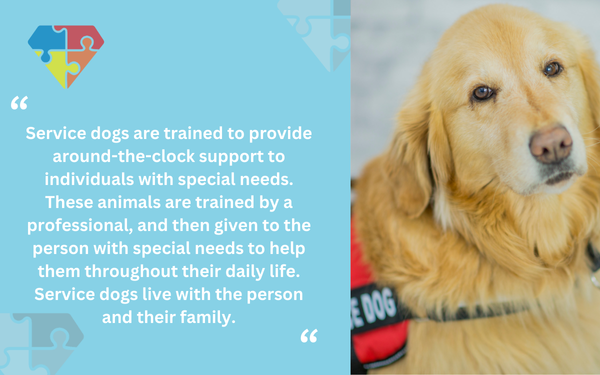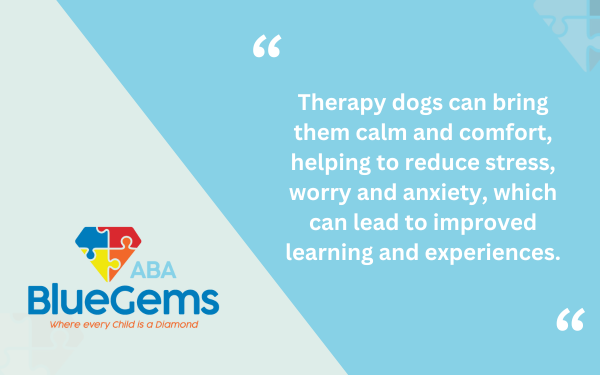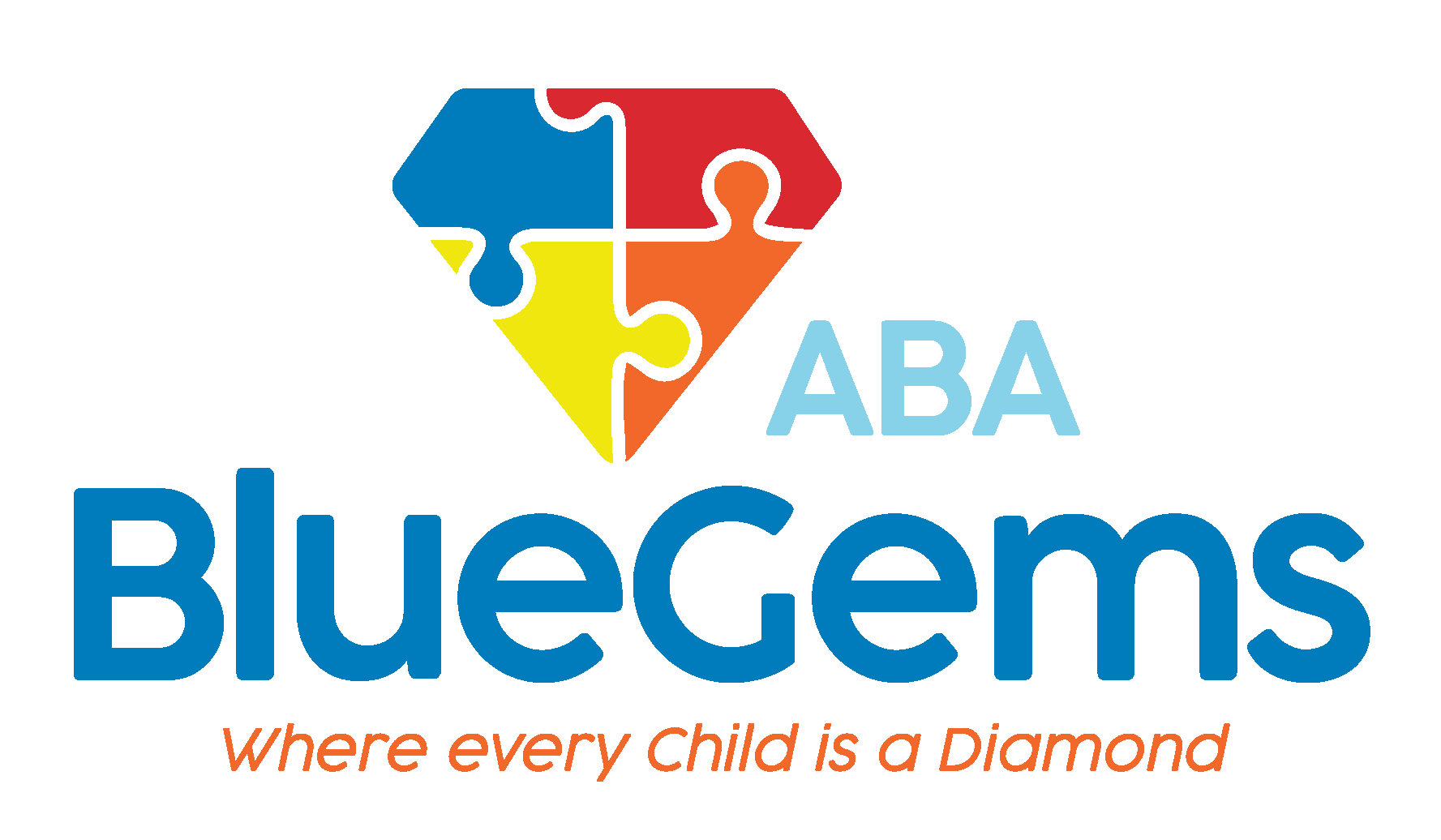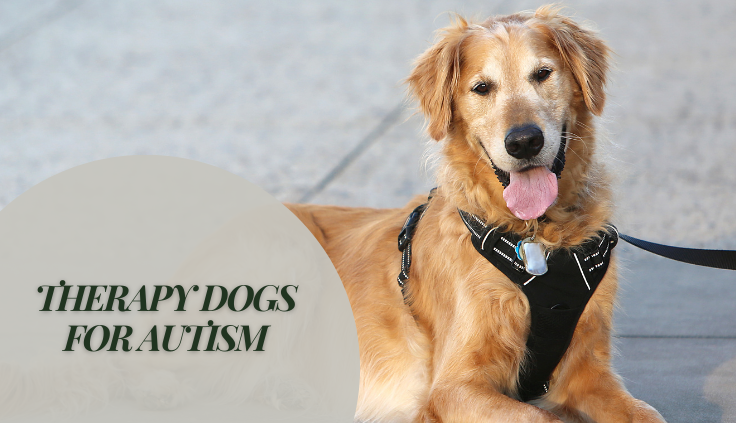Therapy Dogs for Autism
Children with autism spectrum disorder (ASD) often experience the world around them in very different ways than their neurotypical peers. They commonly face challenges with communication and social interaction, and also may experience sensory sensitivities.
While the symptoms of autism can range greatly from one person to the next, the fact remains that they are more likely to experience things such as restrictive interests and repetitive behaviors, social withdrawal and mental health issues such as anxiety.
Tried-and-true treatment plans such as applied behavior analysis, or ABA therapy, have proven to be extremely beneficial for children on the autism spectrum, helping them gain the social and communication skills they may lack, while helping them modify certain negative and/or harmful behaviors.
There are other types of therapies that can also be used in conjunction with ABA therapy to help children with ASD experience the world around them in more calm ways. One example is using therapy dogs, which can reduce stress and allow children to learn more easily.
Below, we’ll discuss therapy dogs for autism and the benefits they can provide.
Learn more about Animal Assisted Therapy for Autism
Table Of Contents
What Are Therapy Dogs for Autism?
Therapy dogs are dogs that are specifically trained to provide support services to children with autism. They are similar in many ways to service dogs or companion dogs, but there are also stark differences as well.
Service dogs are trained to provide around-the-clock support to individuals with special needs. These animals are trained by a professional, and then given to the person with special needs to help them throughout their daily life. Service dogs live with the person and their family.

Companion dogs are essentially family pets. However, they are often specific breeds that have a certain temperament and can provide specific benefits to people with special needs. While companion dogs may not be professionally trained, they are often vetted for the family who needs them.
Therapy dogs, by contrast, are usually professionally trained as service dogs are, but they don’t belong to the person who has special needs. Instead, they are brought into a situation or environment for a specific therapy by their handlers, and then taken back to their home when the therapy is done.
| Dog Type | Training Level | Lives With Family | Purpose | Ownership |
|---|---|---|---|---|
| Service Dog | Professionally trained | Yes | Daily support for individuals with disabilities | Owned by family |
| Companion Dog | Usually untrained | Yes | Emotional comfort, general companionship | Owned by family |
| Therapy Dog | Professionally trained | No | Used temporarily in therapy sessions | Handler-owned |
How Are Therapy Dogs Used for Autism?
Many studies have shown that dogs can bring comfort and calm to people. They can help to encourage people to bond with others, essentially serving as a social catalyst.
Therapy dogs have been brought into plenty of environments to provide calm and companionship in the past, including to senior citizen communities and hospitals where patients must stay for longer periods of time.
They have also shown some benefits for children on the autism spectrum as well.
One review highlighted that therapy dogs can help children with ASD develop essential social and communication skills. One of the six studies that were part of the review concluded that children with autism were more engaged and vocal in their therapy sessions when there were dogs present.
The therapy dogs can be integrated into ABA therapy or whatever treatment a child with ASD is receiving to help calm them down and make them feel more comfortable. They can even be relatable to the children, as many of the therapy dogs will wear a cape that identifies them as a therapy dog, which many of the children might find fun.
What Are Some of the Benefits Therapy Dogs Can Provide Children with Autism?
One of the main benefits therapy dogs can provide is a sense of calm and comfort.
Many children on the autism spectrum can get easily overwhelmed and anxious. This can stand in the way of them learning skills, building meaningful relationships and generally interacting with the world around them.
Therapy dogs can bring them calm and comfort, helping to reduce stress, worry and anxiety, which can lead to improved learning and experiences.

In much the same way, therapy dogs can bring calm to children with autism while they’re having a meltdown. If a child becomes overwhelmed at a situation or is having trouble expressing their emotions, for instance, a therapy dog can bring them a sense of safety and calm, providing reassurance in a situation that is often fraught with fear.
Children also build strong relationships with therapy dogs, which then helps them express themselves better. This provides benefits in terms of helping them build meaningful relationships with peers, while also improving their communication skills.
| Benefit Area | Description |
|---|---|
| Emotional Regulation | Reduces anxiety, calms meltdowns, and helps children feel safe |
| Social Interaction | Encourages bonding and helps build peer relationships |
| Communication Skills | Improves verbal engagement and expression |
| Therapy Enhancement | Makes ABA sessions more engaging and comfortable |
| Relatability and Comfort | Children relate to dogs and enjoy their presence (e.g., capes, routines) |
Blue Gems ABA Supports Children on the Autism Spectrum
Therapy dogs can provide children with ASD plenty of emotional support, helping to calm them down while also aiding them in building their social and emotional skills. When integrated as a part of a comprehensive ABA therapy plan, they can provide tremendous results for children.
At Blue Gems ABA, we are committed to supporting children on the autism spectrum by administering ABA therapy on a one-to-one basis. We craft personalized treatment plans that cater specifically to each individual child’s unique strengths and challenges, which provides them with exceptional benefits.
To learn more, please contact us today.




